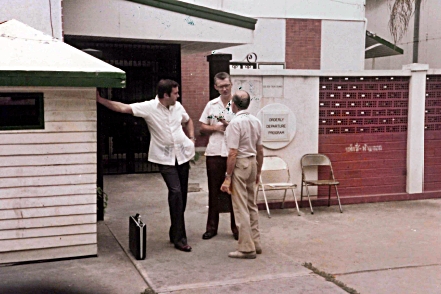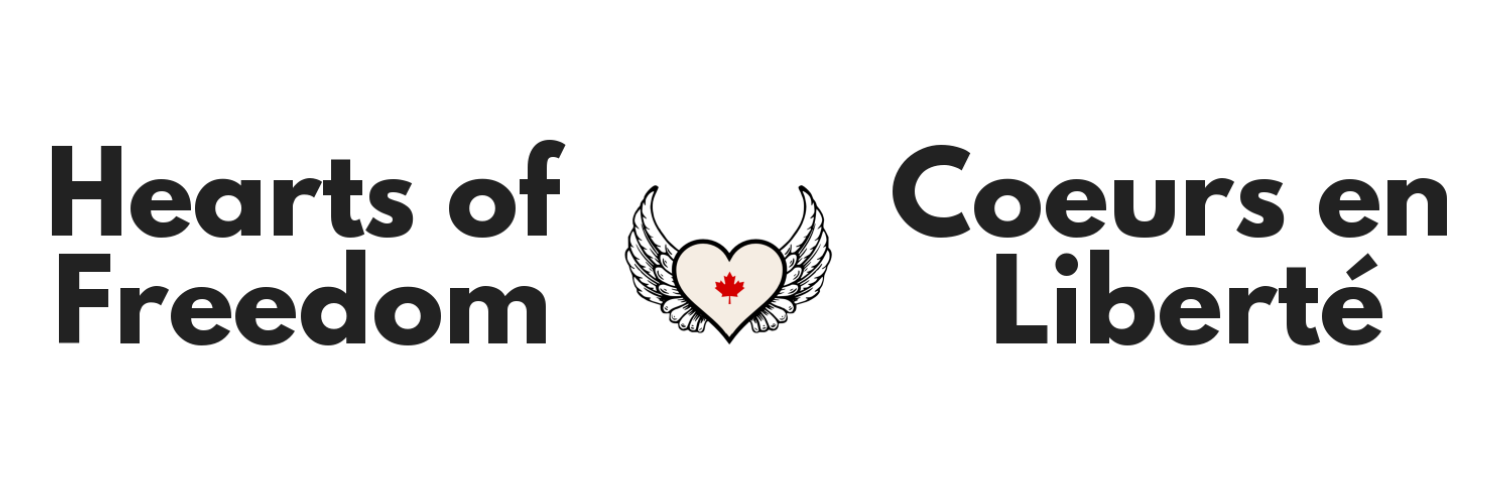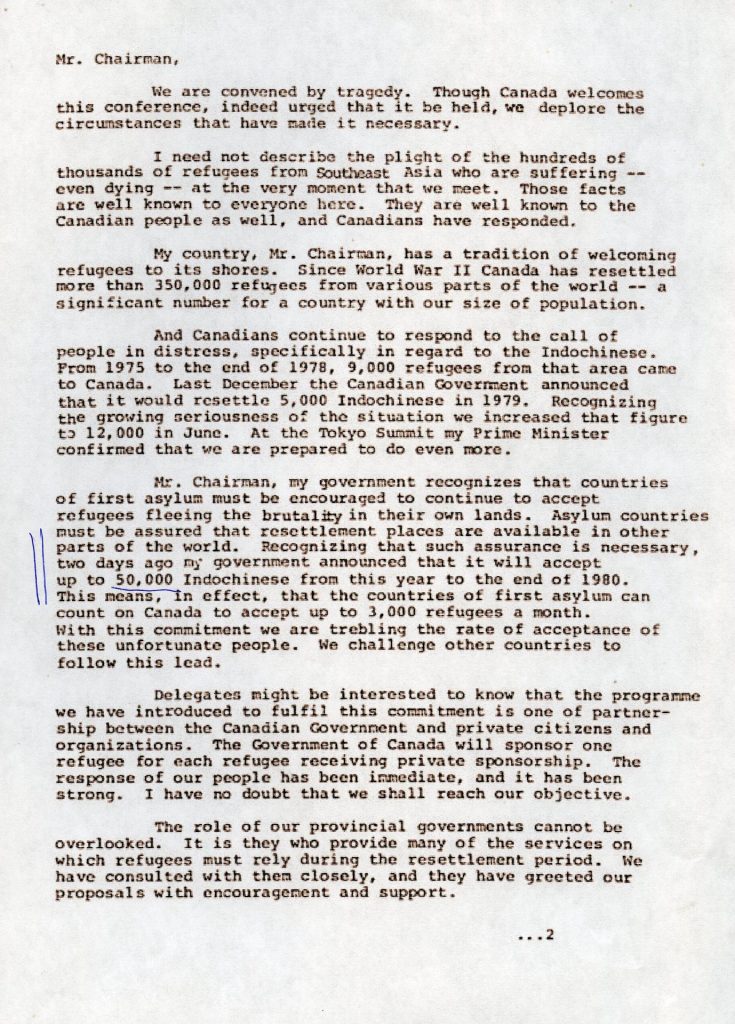Canadian Government Policy and Private Sponsorship
Canada’s refugee resettlement efforts have deep roots. In 1947, Canada recognized a “moral obligation” towards people displaced by World War Two and by 1951 186,000 arrived in Canada. Subsequently Canada’s resettlement policy, responding to the Cold War, focused on Eastern Europeans who escaped from countries dominated by the Soviet Union including 37,000 Hungarians in 1956-7 and 11,900 Czechoslovakians in 1968-9. Canada’s race based immigration policy was set aside in1962 and in 1967, a new “universal” immigration policy based on the “point system” solidified the shift from race as a criteria to individual qualifications, labour market needs and family reunification. After ratifying the 1951 UN Refugee Convention in 1969 the government established a resettlement policy using the UN refugee definition to identify refugees combined with a soft application of the point system. The nearly 9,000 Southeast Asian refugees who came to Canada between the fall of Saigon in 1975 and 1978 were admitted under this policy as Convention refugees or under family reunification.
1976 Act
Private Refugee Sponsorship Program
In 1976 Parliament passed a new immigration act which rooted in law outlined the protection and resettlement of refugees. For the Vietnamese, Laotian and Cambodians refugee populations building up in Southeast Asia, two new provisions of the 1976 Act were especially important. The first was the creation of the private refugee sponsorship program (PSR) under which Canadian national and local institutions and even groups of five individuals could sponsor refugees by undertaking responsibility for their resettlement for a one year. The Mennonite Central Committee (MCC), the first institution to recognize the new program’s humanitarian potential, signed a Master Agreement with the government in March 1979. Under the agreement the MCC accepted liability if local Mennonite congregations which had sponsored refugees ran into difficulties. Other religious communities quickly followed.


1978
The Indochinese Designated Class
The second relevant provision of the 1976 Act empowered the government to create designated classes for displace and persecuted people exempting them from the strictures of the UN Convention definition. The Indochinese Designated Class, which came into effect in late 1978, targeted people who had fled Vietnam, Laos and Cambodia after April 1975 and both simplified and streamlined the selection process. Administrative instructions accompanying the Indochinese Designated Class emphasized the importance of keeping extended families together, a practice that distinguished the Canadian program for those of other resettlement countries.
The private sponsorship program and the Indochinese Designated Class provided the underpinnings for Canada’s response to the Southeast Asian refugees from 1979 onward. The year 1979 began with a Liberal government’s commitment to resettle 5,000 refugees. In June 1979, the new Conservative government increased this to 8,000 and suggested private sponsors could resettled an additional 4,000. However, it was clear that more was needed, and in July 1979 the government announced Canada would resettle 50,000 refugees by the end of 1980. This consisted of the 8,000 already “in the pipeline” plus 21,000 to be privately sponsored matched by 21,000 to be resettled by the government. The succeeding Liberal government added 10,000 government assisted refugees in the spring of 1980.
Charter Flight 181
Charter flight 181 arriving in December 1980 brought the last of 60,049 refugees. This included 32,000 privately sponsored, 1,790 relative sponsored and 25,978 government assisted. Of these 42,664, there were 9,849 Vietnamese, 4,697 Laotians and Cambodians, plus 2,839 others.

Between 1981 and 1997, Canada resettled
117,248
Vietnamese
16,829
Cambodians
7272
Laotian
ODP
Orderly Departures Program
In addition, the UNHCR and the Vietnamese government had negotiated the Orderly Departures Program (ODP) which permitted relatives and humanitarian cases to emigrate legally from Vietnam. Under the ODP, 64,955 Vietnamese and Cambodians were reunited with family members in Canada. Taken together, the Southeast Asian refugees and their relatives resettled by Canada between1975 and 1997 totalled 210,000.


Nansen medal
Think globally and act locally.
The private sponsorship program, launched as the refugee crisis peaked in 1978-9, gave the Canadian public an opportunity to “think globally and act locally.” In 1979 and 1980, Canadians submitted more than 7,000 sponsorships and thousands more would follow. For Canadians who sponsored refugees, multiculturalism ceased to be vague policy and became a lived experience. For the refugees themselves, being welcomed and assisted by deeply concerned citizen softened the challenges of adapting to such a profoundly different society and provided a vivid and lasting demonstration of the best of Canadian values. It was that citizen participation that caught the attention of the UNHCR and led to the decision to award the Nansen Medal, uniquely, to the people of Canada.
Mr. Chairman, my government recognizes that countries of first asylum must be encouraged to continue to accept refugees fleeing the brutality in their own lands. Asylum countries must be assured that resettlement places are available in other parts of the world. Recognizing that such assurance is necessary, two days ago my government announced that it will accept up to 50,000 Indochinese from this year to the end of 1980. This means, in effect, that the countries of first asylum can count on Canada to accept up to 3,000 refugees a month. With this commitment we are trebling the rate of acceptance of these unfortunate people. We challenge other countries to follow this lead…
Flora MacDonald – Canadian Minister of Foreign Affairs.




